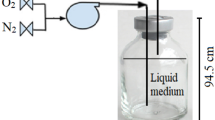Abstract
The anaerobic degradation ofm-cresol was studied in a denitrifying bacterium. In the initial studies, hypothetical intermediates ofm-cresol degradation were tested in growth experiments and in adaptation studies with dense cell suspensions. Results suggested a degradation ofm-cresol via 3-hydroxybenzoate. To verify this, the degradation ofm-cresol was followed in concentrated cell suspensions in the presence of metabolic inhibitors. Fluoroacetate treatment resulted in the transient accumulation of substantial amounts of 3-hydroxybenzoate. In the presence of iodoacetamide, not only was 3-hydroxybenzoate transiently formed, but benzoate was also accumulated. These findings support a degradation ofm-cresol via initial anaerobic methyl oxidation to 3-hydroxybenzoate, followed by reductive dehydroxylation to benzoate or benzoyl-CoA. Studies with extracts ofm-cresol-grown cells showed the presence of several enzyme activities to be postulated for this pathway. No evidence was found for a carboxylation, hydroxylation of the aromatic ring, or direct ring reduction as the initial step inm-cresol metabolism.
Similar content being viewed by others
References
Altenschmidt U, Fuchs G (1991) Anaerobic degradation of toluene in denitrifyingPseudomonas sp.: indication for toluene methyl-hydroxylation and benzoyl-CoA as a central intermediate. Arch Microbiol 156:152–158
Altenschmidt U, Fuchs G (1992) Anaerobic toluene oxidation to benzyl alcohol and benzaldehyde in a denitrifyingPseudomonas strain. J Bacteriol 174:4860–4862
Biegert T, Altenschmidt U, Eckershorn C, Fuchs G (1993) Enzymes of anaerobic metabolism of phenolic compounds. 4-Hydroxybenzoate-CoA ligase from a denitrifyingPseudomonas species. Eur J Biochem 213:555–561
Bisaillon J-G, Lépine F, Beaudet R, Sylvestre M (1991) Carboxylation ofo-cresol by an anaerobic consortium under methanogenic conditions. Appl Environ Microbiol 57:2131–2134
Bossert ID, Young LY (1986) Anaerobic oxidation ofp-cresol by a denitrifying bacterium. Appl Environ Microbiol 52:1117–1122
Bossert ID, Whited G, Gibson DT, Young LY (1989) Anaerobic oxidation ofp-cresol mediated by a partially purified methyl-hydroxylase from a denitrifying bacterium. J Bacteriol 171: 2956–2962
Brackmann R, Fuchs G (1993) Enzymes of anaerobic metabolism of phenolic compounds. 4-Hydroxybenzoyl-CoA reductase (dehydroxylating) from a denitrifyingPseudomonas species. Eur J Biochem 213:563–571
Bradford, MM (1976) A rapid and sensitive method for the quantitation of microgram quantities of protein utilizing the principle of protein-dye binding. Anal Biochem 72:248–254
Chalmers RM, Fewson CA (1989) Purification and characterization of benzaldehyde dehydrogenase I fromAcinetobacter calcoaceticus. Biochem J 263:913–919
Dagley S (1971) Catabolism of aromatic compounds by microorganisms. Adv Microb Physiol 6:1–46
Dangel W, Brackmann R, Lack A, Mohamed M, Koch J, Oswald B, Seyfried B, Tschech A, Fuchs G (1991) Differential expression of enzyme activities initiating anoxic metabolism of various aromatic compounds via benzoyl-CoA. Arch Microbiol 155:256–262
Fuchs G, Mohamed M, Altenschmidt U, Koch J, Brackmann R, Lochmeyer C, Oswald B (1994) Biochemistry of anaerobic degradiation of aromatic compounds. In: Ratledge C (ed) Biochemistry of microbial degradiation. Kluwer, Dordrecht, pp 513–553
Gesellschaft Deutscher Chemiker (1979) Deutsche Einheitsverfahren zur Wasser-, Abwasser-und Schlammuntersuchung. 8. Lieferung D9: pp 1–8
Gorny N, Schink B (1994) Anaerobic degradation of catechol byDesulfobacterium sp. strain Cat2 proceeds via carboxylation to protocatechuate. Appl Environ Microbiol 60:3396–3400
Hopper DJ (1978) Incorporation of [18O]water in the formation ofp-hydroxybenzyl alcohol by thep-cresol methylhydroxylase fromPseudomonas putida. Biochem J 175:345–347
Hopper DJ (1988) Properties ofp-cresol methylhydroxylases. In: Hagedom SR, Hansen RS, Kurz, DA (eds) Microbial metabolism and the carbon cycle, a symposium in honor of Stanley Dagley. Harwood, Chur, pp 247–258
Kim M-K, Harwood CS (1991) Regulation of benzoate-CoA ligase inRhodopseudomonas palustris. FEMS Microbiol Lett 83:199–204
Koch J, Fuchs G (1992) Enzymatic reduction of benzoyl-CoA to alicyclic compounds, a key reaction in anaerobic metabolism. Eur J Biochem 205:195–202
Koch J, Eisenreich W, Bacher A, Fuchs G (1993) Products of enzymatic reduction of benzoyl-CoA, a key reaction in anaerobic aromatic metabolism. Eur J Biochem 211:649–661
Lack A, Tommasi I, Aresta M, Fuchs G (1991) Catalytic properties of phenol carboxylase. In vitro study of CO2: 4-hydroxybenzoate isotope exchange reaction. Eur J Biochem 197:473–479
Londry KL, Fedorak PM (1993) Use of fluorinated compounds to detect aromatic metabolites fromm-cresol in a methanogenic consortium: evidence for a demethylation reaction. Appl Environ Microbiol 59:2229–2238
Mueller JG, Chapman PJ, Hap Pritchard P (1989) Creosote-contaminated sites. Environ Sci Technol 23:1197–1201
Pfennig N (1978)Rhodocyclus purpureus gen. nov. and sp. nov., a ring-shaped, vitamin B12-requiring member of the familyRhodospirillaceae. Int J Syst Bacteriol 28:283–288
Rabus R, Nordhaus R, Ludwig W, Widdel F (1993) Complete oxidation of toluene under strictly anoxic conditions by a new sulfate-reducing bacterium. Appl Environ Microbiol 59:1444–1451
Ramanand K, Suflita JM (1991) Anaerobic degradation ofm-cresol in anoxic aquifer slurries: carboxylation reactions in a sulfate-reducing bacterial enrichment. Appl Environ Microbiol 57:1689–1695
Ramanand K, Suflita JM (1993) Carboxylation and mineralization ofm-cresol by a sulfate-reducing bacterial enrichment. Curr Microbiol 26:327–332
Rider DJ, Mellon MG (1946) Colorimetric determination of nitrites. Ind Eng Chem 18:96–98
Roberts DJ, Fedorak PM, Hrudey SE (1990) CO2 incorporation and 4-hydroxy-2-methylbenzoic acid formation during anaerobic metabolism ofm-cresol by a methanogenic consortium. Appl Environ Microbiol 56:472–578
Rudolphi A, Tschech A, Fuchs G (1991) Anaerobic degradation of cresols by denitrifying bacteria. Arch Microbiol 155:238–248
Schocher RJ, Seyfried B, Vazquez F, Zeyer J (1991) Anaerobic degradation of toluene by pure cultures of denitrifying bacteria. Arch Microbiol 157:7–12
Smolenski WJ, Suflita JM (1987) Biodegradation of cresol isomers in anoxic aquifers. Appl Environ Microbiol 53:710–716
Tschech A, Pfennig N (1984) Growth yield increase linked to caffeate reduction inAcetobacterium woodii. Arch Microbiol 137:163–167
Tschech A, Fuchs G (1987) Anaerobic degradation of phenol by pure cultures of newly isolated denitrifyingPseudomonads. Arch Microbiol 148:213–217
Widdel F, Kohring GW, Mayer F (1983) Studies on dissimilatory sulfate-reducing bacteria that decompose fatty acids. III. Characterization of the filamentous glidingDesulfonema limicola gen. nov. sp. nov., andDesulfonema magnum sp. nov. Arch Microbiol 134:286–294
Author information
Authors and Affiliations
Rights and permissions
About this article
Cite this article
Bonting, C.F.C., Schneider, S., Schmidtberg, G. et al. Anaerobic degradation ofm-cresol via methyl oxidation to 3-hydroxybenzoate by a denitrifying bacterium. Arch. Microbiol. 164, 63–69 (1995). https://doi.org/10.1007/BF02568736
Received:
Accepted:
Issue Date:
DOI: https://doi.org/10.1007/BF02568736




